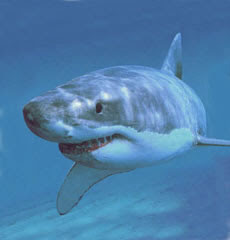As a continuation of my last post, I give you an oddly shaped shark: The Hammerhead. Unlike the Great White, who is implicated in 32.7% of all shark attacks, and the Tiger Shark, who is implicated in 14% of all shark attacks, the Hammerhead Shark is implicated in 0.7% of all shark attacks, according to the
International Shark Attack File.
Hammerhead Sharks are commonly known because of their appea

rance.
The Merriam-Webster Dictionary defines it as "any of a family (sphyrnidae) of active voracious medium-sized sharks that have eyes at the ends of lateral extension of the flattened head" This means that they are a shark that eats a lot, and who's eyes are placed in a rather intriguing position. Check out this Hammerhead on the right. Ugly isn't he?

Hammerheads eat smaller fish, octopus, squid, crustaceans, and even sting rays, which it pins to the ocean floor using its wide head. According to
National Geographic, The Great Hammerhead Shark can grow to be 20 ft in length, and weigh over 1,000 lbs. Although most Hammerheads are rather small, the Great Hammerhead is among the top nine largest identified species of shark. Unlike a pet goldfish, who's lucky to live two weeks, the Hammerhead can live to be 30 years old, and spend their lives in both temperate and tropical waters, traveling in large groups, or schools.
Although the Hammerhead is a fish, babies are fed placenta, and are born, rather then hatched. Hammerheads are viviparous, which means that the eggs hatch inside the female's body, and that Hammerheads give birth to live young. Hammerheads can have anywhere from 13 to 42 babies, or pups, per litter. But despite the fact that Hammerheads have many pups, their population is declining. According to the
MarineBio organization, "hammerheads are a bycatch species of tropical longline and drift net fisheries with highly valued fins". Hammerhead meat is also sold for human consumption, and can be bough fresh, frozen, dried, or smoked.
According to the
Shark Foundation, Sharks existed 400 million years ago and have sense evolved into the species they are now. Hammerhead Sharks have evolved to have their current head structure which allows them 360° vision and greater stereo vision, or depth perception.
Hammerheads aren't rare, but are always interesting, and cool to see. Have fun watching SHARK WEEK, and remember: Fish are friends. Not food.





 A Bull Shark primarily eats fish, and smaller sharks, and humans rarely enter their diet. Like the Hammerhead Shark, the Bull enjoys the occasional Sting Ray, and has also been known to eat young sharks of their own species. Oddly enough Bull Sharks also enjoy Sea Turtles, Sea Gulls, Dolphins, and Squid. The Bull Shark will appear slow, and rather clumsy, but appearances can be deceiving. When hunting the Bull Shark will turn quick and extremely agile.
A Bull Shark primarily eats fish, and smaller sharks, and humans rarely enter their diet. Like the Hammerhead Shark, the Bull enjoys the occasional Sting Ray, and has also been known to eat young sharks of their own species. Oddly enough Bull Sharks also enjoy Sea Turtles, Sea Gulls, Dolphins, and Squid. The Bull Shark will appear slow, and rather clumsy, but appearances can be deceiving. When hunting the Bull Shark will turn quick and extremely agile.




 The two sharks that most commonly attack are the Great White: Shown in the picture above, and the Tiger Shark, to the left.
The two sharks that most commonly attack are the Great White: Shown in the picture above, and the Tiger Shark, to the left.

